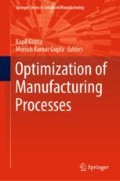Abstract
This chapter explores the application of a hybrid approach namely multi-objective optimization based on ratio analysis (MOORA) in fuzzy context to obtain the best parametric combination during machining of commercially pure titanium (CP-Ti) Grade 2 with uncoated carbide inserts in dry cutting environment. A series of experiment was performed by adopting Taguchi based L27 orthogonal array. Cutting speed, feed rate, and depth of cut were selected as three process variables whereas cutting force, surface roughness and flank wear were selected as three major quality attributes to be minimized. The minimization was exploited using fuzzy embedded MOORA method and hence an optimal parametric combination was attained. The results of the investigation clearly revealed that, the fuzzy coupled with MOORA method, was capable enough in acquiring the best parametric setting during turning operation under specified cutting conditions.
Access this chapter
Tax calculation will be finalised at checkout
Purchases are for personal use only
References
Budinski KG (1991) Tribological properties of titanium alloys. Wear 151(2):203–217
Palraj S, Venkatachari G (2008) Effect of biofouling on corrosion behaviour of grade 2 titanium in Mandapam seawaters. Desalination 230(1):92–99
Zitter H, Plenk H (1987) The electrochemical behavior of metallic implant materials as an indicator of their biocompatibility. J Biomed Mater Res 21(7):881–896
Lautenschlager EP, Monaghan P (1993) Titanium and titanium alloys as dental materials. Int Dent J 43(3):245–253
Aziz-Kerrzo M, Conroy KG, Fenelon AM, Farrell ST, Breslin CB (2001) Electrochemical studies on the stability and corrosion resistance of titanium-based implant materials. Biomaterials 22(12):1531–1539
Ezugwu EO, Wang ZM (1998) Titanium alloys and their machinability—a review. J Mater Process Technol 68:262–274
Ezugwu EO, Bonney J, Yamane Y (2000) An overview of the machinability of aero-engine alloys. J Mater Process Technol 134:233–253
Narutaki N, Murakhoshi A (1983) Study on machining of titanium alloys. CIRP Ann Manuf Technol 32(1):65–69
Jawaid A, Che-Haron C, Abdullah A (1999) Tool wear characteristics in turning of titanium alloy Ti-6246. J Mater Process Technol 92:329–334
Leyens C, Peters M (2003) Titanium and titanium alloys. Wiley Online Library
Settineri L et al (2014) An evaluative approach to correlate machinability, microstructures, and material properties of gamma titanium aluminides. CIRP Ann Manuf Technol 63(1):57–60
Lalwani D, Mehta N, Jain P (2008) Experimental investigations of cutting parameters influence on cutting forces and surface roughness in finish hard turning of MDN250 steel. J Mater Process Technol 206(1):167–179
Aouici H et al (2012) Analysis of surface roughness and cutting force components in hard turning with CBN tool: prediction model and cutting conditions optimization. Measurement 45(3):344–353
Asiltürk I, Neşeli S (2012) Multi response optimisation of CNC turning parameters via Taguchi method-based response surface analysis. Measurement 45(4):785–794
Hashmi KH et al (2016) Optimization of process parameters for high speed machining of Ti-6Al-4 V using response surface methodology. Int J Adv Manuf Technol 85(5–8):1847–1856
Tebassi H et al (2017) On the modeling of surface roughness and cutting force when turning of Inconel 718 using artificial neural network and response surface methodology: accuracy and benefit. Period Polytech Mech Eng 61(1):1
Chandrasekaran M, Muralidhar M, Krishna CM, Dixit U (2010) Application of soft computing techniques in machining performance prediction and optimization: a literature review. Int J Adv Manuf Technol 46(5–8):445–464
Abburi N, Dixit U (2006) A knowledge-based system for the prediction of surface roughness in turning process. Robot Comput Integr Manuf 22(4):363–372
Basheer AC, Dabade UA, Joshi SS, Bhanuprasad V, Gadre V (2008) Modeling of surface roughness in precision machining of metal matrix composites using ANN. J Mater Process Technol 197(1):439–444
Mathonsi T, Laubscher RF, Gupta K (2018) Investigation on high speed machining of titanium grade 2 under MQL conditions. In: Proceedings of 16th international conference on manufacturing research 2018, Skovde (Sweden), Advances in manufacturing technology XXXII, pp 69–74. IOS Press
Miller T, Gupta K, Laubscher RF (2018) An experimental study on MQL assisted high speed machining of NiTi shape memory alloy. In: Proceedings of 16th international conference on manufacturing research 2018, Skovde (Sweden), Advances in manufacturing technology XXXII, pp 80–85. IOS Press
Mathonsi T, Laubscher RF, Gupta K (2018) On machinability of titanium grade 4 under minimum quantity lubrication assisted high speed machining. In: Conference of the South African Advanced Materials Initiative (CoSAAMI-2018). IOP conference series: materials science and engineering, vol 430, p 012013
Gupta K, Laubscher RF (2016) MQL assisted machining of grade-4 titanium. In: Proceedings of international conference on competitive manufacturing (COMA), Stellenbosch (South Africa), pp 211–217, 27–29 Jan 2016
Singaravel B, Selvaraj T (2015) Optimization of machining parameters in turning operation using combined TOPSIS and AHP method. Tehnicki Vjesnik 22(6):1475–1480
Sofuoglu MA, Orak S (2017) A novel hybrid multi criteria decision making model: application to turning operations. Int J Intell Syst Appl Eng 5(3):124–131
Khan A, Maity K. Selection of optimal machining parameters in turning of CP-Ti grade 2 using a hybrid optimization technique
Khan A, Maity K (2016) Parametric optimization of some non-conventional machining processes using MOORA method. Int J Eng Res Afr 20:19–40. Trans Tech Publications
Khan A, Maity K (2017) Application of MCDM-based TOPSIS method for the selection of optimal process parameter in turning of pure titanium. Benchmark Int J 24(7):2009–2021
Khan A, Maity K (2018) Application potential of combined fuzzy-TOPSIS approach in minimization of surface roughness, cutting force and tool wear during machining of CP-Ti grade II. Soft Comput, 1–12
Zadeh L (1965) Fuzzy sets. Inf Control 8(3):338–353
Author information
Authors and Affiliations
Corresponding author
Editor information
Editors and Affiliations
Rights and permissions
Copyright information
© 2020 Springer Nature Switzerland AG
About this chapter
Cite this chapter
Khan, A., Maity, K., Jhodkar, D. (2020). An Integrated Fuzzy-MOORA Method for the Selection of Optimal Parametric Combination in Turing of Commercially Pure Titanium. In: Gupta, K., Gupta, M. (eds) Optimization of Manufacturing Processes. Springer Series in Advanced Manufacturing. Springer, Cham. https://doi.org/10.1007/978-3-030-19638-7_7
Download citation
DOI: https://doi.org/10.1007/978-3-030-19638-7_7
Published:
Publisher Name: Springer, Cham
Print ISBN: 978-3-030-19637-0
Online ISBN: 978-3-030-19638-7
eBook Packages: EngineeringEngineering (R0)

